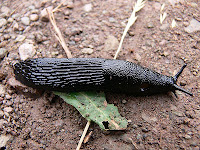 |
| At it A vulgaris c Zollernalb |
 |
| Frost tolerant A ater c Prashanthns |
Slugs will eat almost anything, from growing plants, to carrion, to faeces. Sur le continent, the Spanish slugs have been attacking snail farms: once they've dined on l'escargot they sometimes lay their eggs in the empty shells. Slugs in general seem particularly attracted to other dead or dying slugs. Apparently—and this is where you may need to hold onto your lunches—slugs pose a road hazard, as more and more are drawn to casualties on roads they can create dangerously slippy slicks of squished slugs.
How can you combat slugs? Egg shells, sharp sand, and coffee grounds are all supposed to repel them from tender plants; obviously slug pellets are an option and sales have rocketed this year, but they make sure you use the ferric phosphate kind if you must. Beer traps may catch a few; but let's face it, you'll just end up face down in a drunken stupour, covered in slugs in your garden if you try this. Copper wire around plant pots will stop them climbing in, and of course there's the old salt trick -- although that's not much use for gardeners as salt ain't good for your plants.
Christine Walkden of the Gardeners' Question Time panel last week came up with this stomach churning suggestion related with far too much glee. Collect the slugs from your plants, put them on a patch of pavement, squash them underfoot, leave for a couple of hours for other slugs to hone in on the squashed slugs, go out and trample those underfoot, repeat. This is what I inadvertently ended up doing on my way to and from the pub walking alongside Dartmouth Park Reservoir on Monday evening.*
*AOTW does not advocate the killing of any animals, although I acknowledge that some level of pest control may be necessary. You can encourage other animals that feed on slugs into your garden, but actually, the habit of slugs to curl up into a tough ball and secrete noxious mucus means that many animals will only really eat slugs as a last resort: blackbirds and hedgehogs are likely to be your best friends; badgers and wild boar are also predators of slugs, but also not that great for your garden.
Slugs head to toe
1, Slugs have two pairs of tentacles: the smaller lower pair are used as chemosensors, essentially they're the slugs' sense of smell; the top pair are tipped by the slugs' eyes.
2, The sadle shaped mantle is the real business part of the slug, housing it's organs including it's digestive tract, genitals, and lungs.
3, On the right hand side of the mantle, slugs have a pneumostome, an opening through which air enters the mantle.
4, Slugs are hermaphrodites, although some species still only reproduce in pairs, some, such as Arion vulgaris, will self-fertilize and can produce a fertile brood, if no mates are available.
5, The large part of a slug is its foot, a large muscular organ that propels the slug around on a film of mucus secreted by the slug.
No comments:
Post a Comment